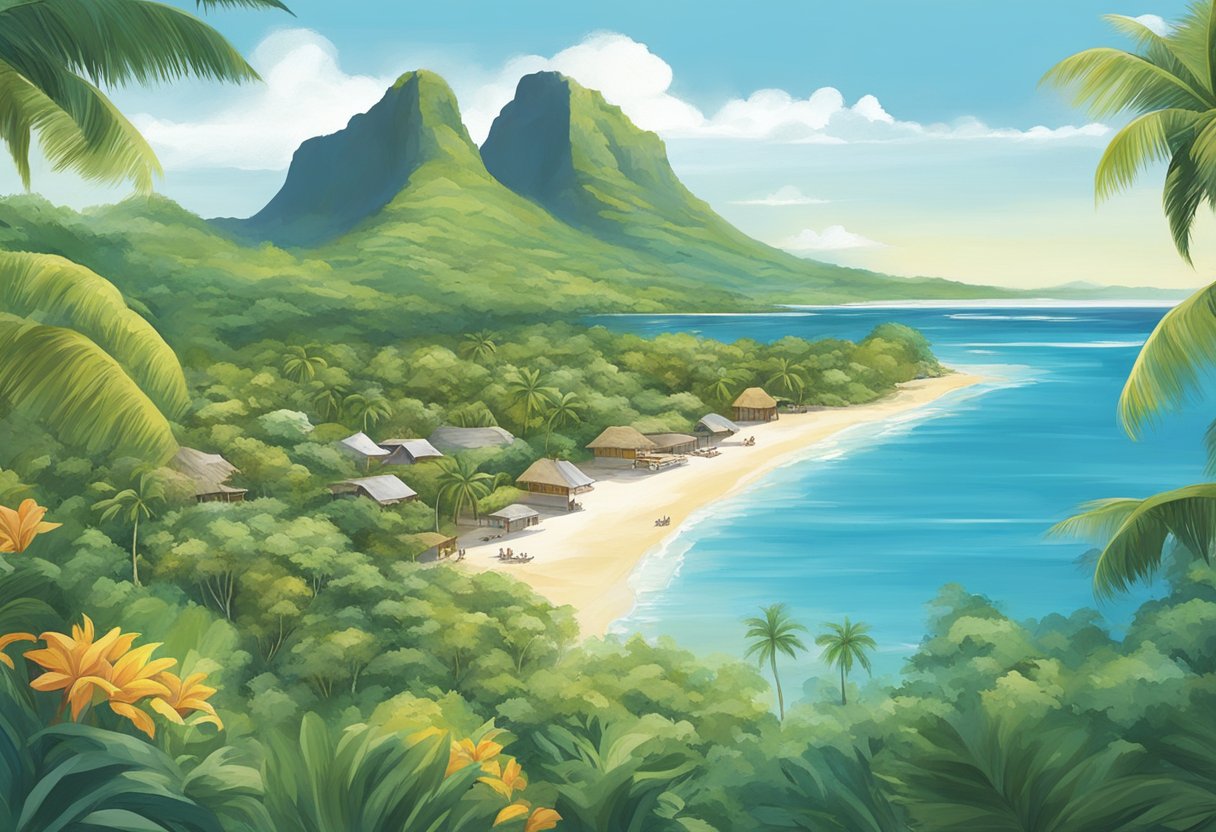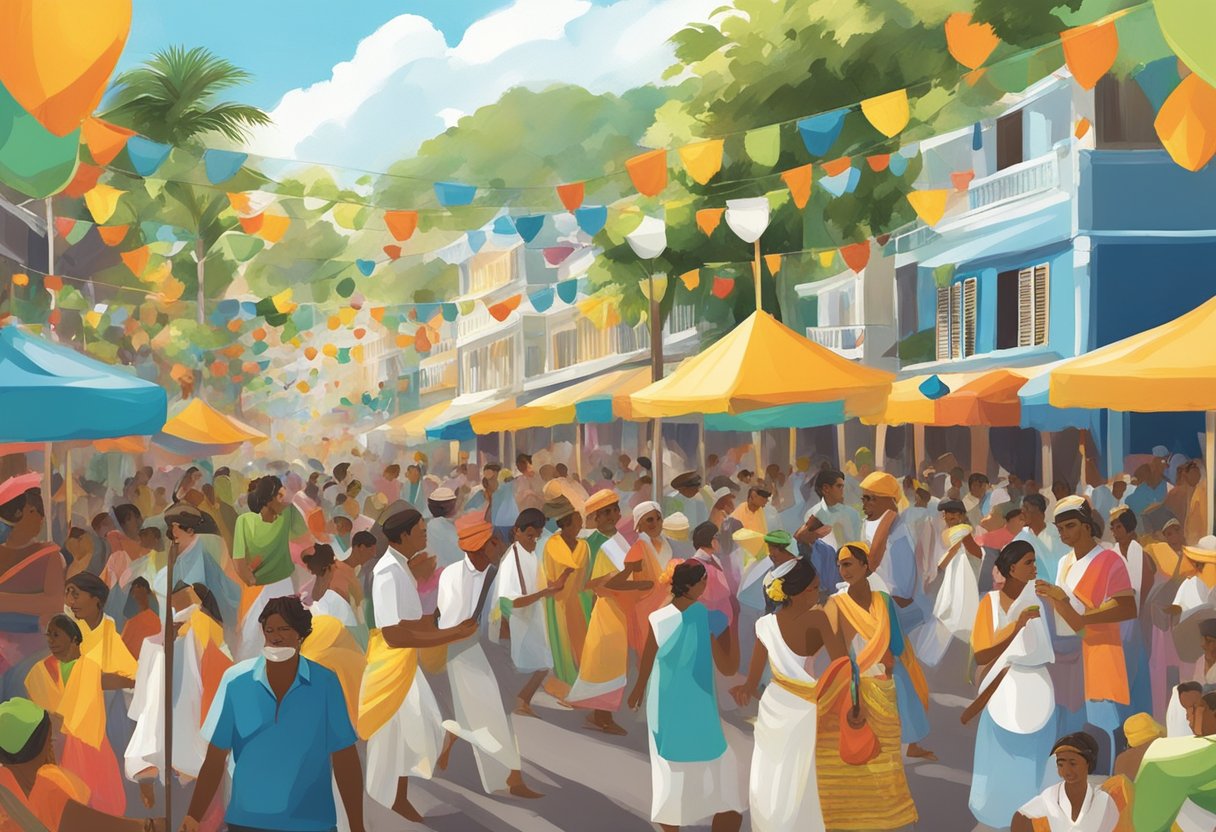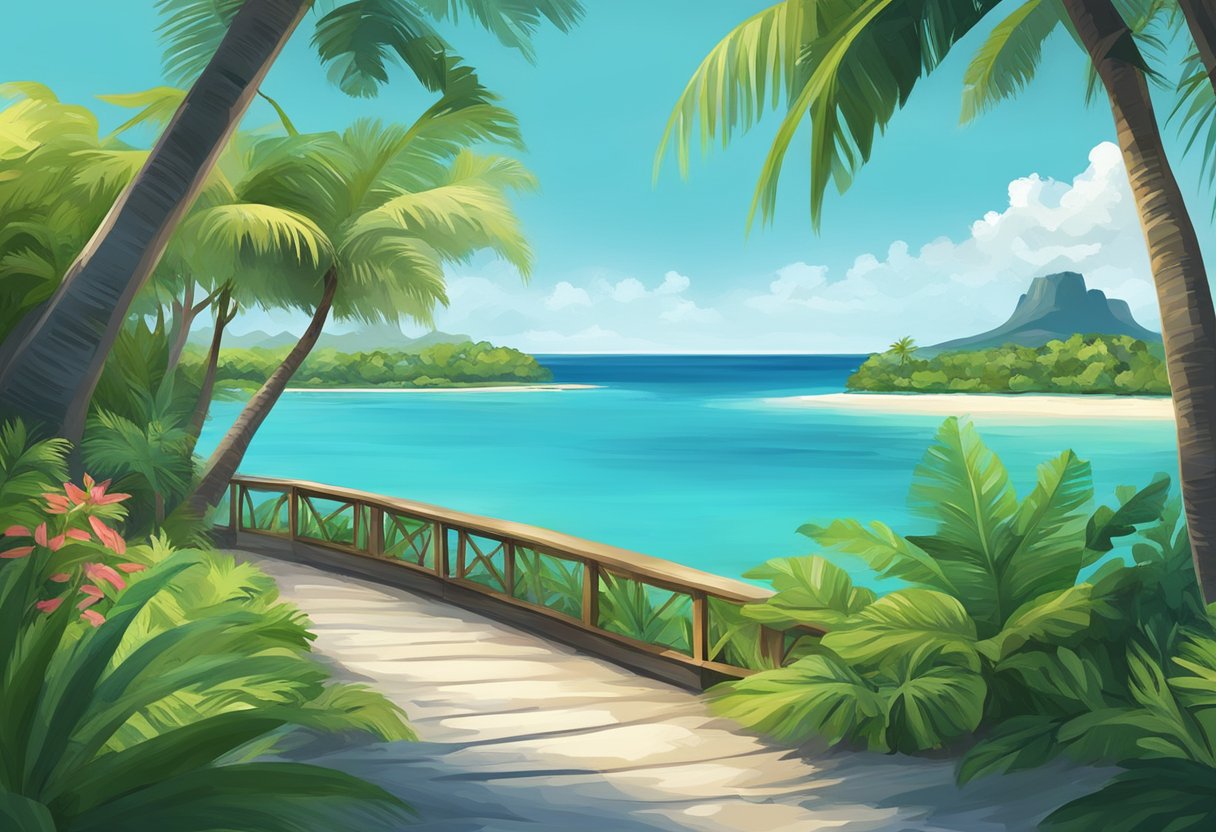Mauritius, a jewel in the Indian Ocean, offers a compelling case for the ideal holiday destination with its pristine beaches, diverse culture, and verdant landscapes. We navigate through the varied climatic patterns of this tropical paradise to zero in on the most opportune times for a visit. Understanding the weather and its impact on outdoor activities is essential, as the island’s climate is a major determinant of our holiday experience.

Throughout the year, Mauritius maintains a relatively mild climate, allowing for flexibility in planning our getaway. Yet, certain months stand out for their particularly pleasant conditions. We find that the periods from April to June and from September to December strike the perfect balance, offering warm, sunny days devoid of the heavy tourist traffic of peak seasons. These months serve up the ideal scenario for us to indulge in everything Mauritius has to offer, from lazing on its sun-kissed beaches to exploring its lush hinterlands.
With only two seasons to consider, summer and winter, we can plan our trip around our preferences for heat and rainfall. Although the Mauritian summer, from November to April, brings higher temperatures and humidity, it also ushers in a lush, green vibrancy that can be quite enchanting. Should cooler, drier days appeal to us, the May to October winter months provide a refreshing alternative, with the added benefit of whale watching off the coast. Explore in depth the best times to visit Mauritius, to enjoy a memorable island retreat tailored to our liking.
Overview of Mauritius
Mauritius, an idyllic island nation, is nestled off the southeast coast of Africa in the expansive Indian Ocean. Renowned for its breathtaking vistas and diverse culture, the island offers us a tapestry of experiences that blend influences from Africa, Europe, and Asia.
Geography
Mauritius is encircled by over 150 km of white sandy beaches and an azure sea. Central Mauritius is adorned with a rugged terrain, composed of mountains and valleys, which is significantly cooler compared to the coastal regions.
Climate
Our island basks in a tropical climate, marked by two distinct seasons: a warm humid summer from November to April and a mild winter from May to October. The climate also varies from region to region; for example, the northern and western parts of Mauritius are warmer and drier compared to the breezy and slightly cooler south and east.
| Climate by Region | Description |
|---|---|
| North & West | Sunniest and driest |
| South & East | Windier, with a cooler climate |
| Central | Cooler than the coast, mountainous |
Cultural Landscape
Mauritius is a melting pot of cultures, offering us a rich heritage that spans food, music, and festivals. From the bustling market of Port Louis to the tranquil fishing villages, its cultural vibrancy is felt throughout the island.
As we consider the regions within Mauritius, we witness a harmonious blend of traditions and modernity. This mosaic of characteristics ensures that our time on this island is filled with authentic and enriching experiences.
Understanding Mauritius’s Climate
Mauritius boasts a tropical climate, which means we experience warm and pleasant temperatures year-round. The island’s weather system is influenced by the southeast trade winds, and as such, our seasons are more distinctly defined as warmer, wetter summers and cooler, drier winters.
During the summer months, from November to April, we anticipate higher temperatures averaging between 25°C to 33°C (77°F to 91°F). This period is characterized by high humidity and more frequent rainfall, especially from January to March when brief, intense showers are common. The summer is also our cyclone season—an important factor to consider if you’re planning your visit.
Winter in Mauritius is from May to October and is generally dryer. Temperatures during this season are mild and more comfortable, ranging on average from 17°C to 24°C (63°F to 75°F). This is when our humidity levels are lower, making it an ideal time for outdoor activities.
The island’s diverse topography means weather can vary by region. The west and north are typically warmer and drier, while the east and south tend to receive more wind and have somewhat cooler temperatures. In the central plateau, it’s not uncommon for temperatures to be several degrees lower than on the coast.
To summarize, we can expect:
- Hot, humid, and wet conditions in the summer.
- Cooler, dry weather in the winter.
- Cyclones possible from November to April.
Understanding these patterns allows us to make the most of Mauritius’s beautiful landscapes and activities, whether we’re basking on sunlit beaches or exploring cultural sites.
Monthly Travel Guide
We’re about to take you through a month-by-month guide to help you identify the best time to visit Mauritius. Each month has its unique climate and activities making Mauritius a great destination year-round.
January in Mauritius
January is one of the hottest and wettest months in Mauritius, with a high chance of cyclones. Despite occasional showers, it’s still a popular time for New Year’s celebrations on the island.
February in Mauritius
In February, it remains hot and humid. As the end of cyclone season approaches, it’s an ideal time for those who enjoy tropical climates and don’t mind the possibility of rain.
March in Mauritius
March, still part of the rainy season, continues with hot temperatures, providing lush greenery across the island, especially in areas like Curepipe.
April in Mauritius
By April, the climate becomes warmer and less windy. It’s a fantastic period to experience the Easter holidays in Mauritius with plenty of sunny days.
May in Mauritius
Coming into May, the weather starts to cool, and conditions become ideal for windsurfing or kite surfing due to the steady winds.
June in Mauritius
June brings cooler weather, perfect for hitting the waves and surfing, plus fewer crowds on the island compared to the busier months.
July in Mauritius
During July, the cool climate is accompanied by trade winds, making it another excellent month for kite surfing and enjoying the less crowded beaches.
August in Mauritius
August sees cool conditions ideal for hiking and exploring the inland trails. It can still be windy this time of year, highlighting the island’s natural beauty.
September in Mauritius
The warmth gradually returns in September, providing clear skies and abundant sunshine, setting the scene for beach outings and outdoor adventures.
October in Mauritius
In October, the temperature is warm, and the beaches start to become more inviting. It’s often considered the start of the best period to visit for sun lovers.
November in Mauritius
By November, we find warm weather with occasional wet spells, but it’s also a good month for diving as marine life is abundant.
December in Mauritius
Finally, December in Mauritius is hot and humid, with the festive season bringing a lively atmosphere and various festivals to enjoy.
Best Time to Visit Mauritius
When planning our journey to Mauritius, we consider various factors to ensure our visit aligns with the island’s most favorable conditions. Based on climate and tourist seasons, we can determine the best time to visit Mauritius. May through November often presents us with milder weather, making it ideal for exploring the outdoors. Specifically, October and November stand out as they offer dry conditions and optimal temperatures.
- Peak Season: The peak tourist season in Mauritius occurs from December to April, coinciding with the summer months. During this period, the island experiences a surge in visitors, especially those seeking to escape the Northern Hemisphere’s winter. However, this is also when Mauritius sees higher prices and more crowded attractions.
- Low Season: The period from May to September is less crowded, presenting us with a quieter experience on the island. Although it is winter, the temperatures remain pleasant, but we might encounter brief rain spells.
| Month | Season | Considerations |
|---|---|---|
| December-April | Summer (High Season) | Warm, humid, risk of cyclones |
| May-September | Winter (Low Season) | Cooler, less rain, fewer tourists |
| October-November | Spring (Best Time) | Warm, dry, ideal for activities |
During the low season, we may benefit from reduced rates on accommodation and flights. This can be seen as the cheapest time to book our trip. However, if we’re seeking the most optimal weather conditions, we should target late spring and early summer, outside of the main tourist surges, to make the most of our visit to Mauritius.
Regional Differences in Mauritius

When planning a visit to Mauritius, it’s important to consider the regional climate variations and activities. Each coast offers distinct experiences and weather conditions that cater to different preferences.
North and West Coast
The North and West coasts of Mauritius are famed for their sun-drenched beaches and calm seas, making it a year-round destination for beach lovers. In these regions, you’ll find some of the finest hotels in Mauritius, such as those near the bustling Grand Baie or the serene Flic en Flac. The clear waters along the west coast are ideal for diving and surfing, especially during the warmer months which tend to attract more tourists.
Eastern Mauritius
Conversely, Eastern Mauritius is known for its windier conditions, which can be particularly noticeable during the winter months, making it a haven for kite surfers and wind-surfers. The beaches along the east coast like Belle Mare boast stunning, long stretches of sand. However, the east is also where you might experience the wettest month of the year, so visitors should be prepared for brief but intense showers.
South and East
Our South and East coast, with its rugged landscapes, offers a more secluded getaway featuring luxury lodges and boutique hotels peppered along the coastline. This region receives more rainfall, but that also sustains lush, green vegetation. It’s a prime area for hiking, such as in the Chamarel Mountains. Although the beaches can have rougher seas and less protection from the wind, they are picturesque and distinctly less crowded, giving you space to enjoy nature in tranquillity.
Events and Festivals

When we talk about the best time to visit Mauritius, we can’t help but think of the island’s vibrant festivals. Throughout the year, Mauritius is home to a range of celebrations that showcase its rich cultural tapestry.
- Celebrated in late January or early February
- Marks the start of the Chinese lunar calendar
- Features lion dances, fireworks, and feasts
Cavadee Festival:
- Held in January or February
- A Tamil festival characterized by feats of endurance
- Devotees carry the ‘cavadee,’ a wooden arch, as a show of devotion
Holi:
- The festival of colors celebrated by the Hindu community
- Takes place in March
- Involves throwing colored powders and water, symbolizing the arrival of spring
National Day:
- March 12th marks the day of independence from British rule
- Parades and flag-raising ceremonies are main events
Kreol Festival:
- A celebration of Creole culture in Mauritius
- Hosts music performances, dance, and local cuisine
These festivities are not just a way to have fun, but also a means for us to immerse ourselves in the local traditions and communal spirit of Mauritius. By timing our visit around these events, we get to experience the island in all its celebratory glory.
Tips and Activities
We know that Mauritius is a treasure trove of experiences with its stunning landscapes and vibrant culture. Below we outline the best activities and things to do, ensuring you make the most of your visit.
Beaches and Water Sports
In Mauritius, our beaches are renowned for their immaculate beauty and the array of water sports available. From the serene Trou aux Biches to the surfers’ paradise of Tamarin Bay, there is a beach for every preference. We recommend trying our hand at surfing or diving into the clear waters to explore the vibrant coral reefs. For a seamless experience, consider booking Mauritius tours that often include activities like kite surfing, paddle boarding, and more.
Hiking and Nature Exploration
For us who revel in nature and seeking an invigorating experience, Mauritius offers exceptional hiking opportunities. The Black River Gorges National Park presents trails winding through lush forests brimming with endemic wildlife. We should aim to trek to the summits for breathtaking views, particularly at Le Morne Brabant, a site with significant cultural heritage. Year-round, the climate is welcoming for hikes, but April to December is often the most comfortable for these activities.
Cultural Experience
We immerse ourselves in the local culture by exploring the vibrant streets of Port Louis, where we can witness the hustle and bustle of daily life and bustling markets. Cultural festivals are aplenty here; they provide a glimpse into the soul of Mauritius. We should partake in the festivities like Diwali or the colorful Holi to truly connect with the rich traditions of the island. By staying at hotels close to these cultural hotspots, we ensure easy access to these festivals and a complete cultural spectacle.
Traveling to Mauritius During Holidays
When contemplating a trip to Mauritius during the holidays, we must consider the island’s seasonal weather and festivities. Easter holidays offer a compelling time to visit.
April, falling just after the high summer season, presents conditions that are both pleasant and accomodating. We can expect less rainfall and more moderate temperatures.
- Temperature Range: 20°C – 28°C
- Activity Tips: Beach visits, Cultural festivals
During Easter, we may engage in unique celebrations reflecting the cultural diversity of Mauritius. From church services to public concerts, there’s a blend of religious reverence and communal joy.
- Easter Special Events:
- Church Services: Attending mass in one of the island’s historic churches.
- Public Gatherings: Folk music and dance showcasing the island’s multicultural heritage.
We must remember, however, that the school holidays during this period can lead to increased local travel. It’s best to book accommodations and activities in advance.
- Planning Ahead: Essential for securing desired travel dates and itineraries.
- Accommodation: Higher demand; early booking recommended.
By considering the variable factors that the holiday season brings, we can experience a smooth and culturally-rich visit to Mauritius, enjoying the balance of festive spirit and relaxing island life.
Accommodation Advice
When planning our trip to Mauritius, considering where to stay is essential. Mauritius offers a diverse range of accommodation options, from luxurious resorts to more cost-effective hotels. Depending on the time of year, we may find different rates and availability.
Peak Season: During the peak months from April to December, when the weather is ideal for beach activities and hiking, it’s advisable to book hotels well in advance. We can expect higher rates during this period due to increased demand.
Off-Peak Deals: Conversely, the cheapest time to stay in hotels in Mauritius is from May to October. This is when hotels may offer more competitive rates, making it an excellent opportunity for us to enjoy the island’s charm at a lower cost.
Location is Key: Our choice of hotel should also be influenced by location. If you prefer quieter areas, the less crowded, east coast might suit our tastes. For those of us looking to be in the heart of Mauritius’ vibrant culture and nightlife, the west coast offers several options.
Here’s a compact list of considerations for our accommodation in Mauritius:
- Booking Timeframe
- Reserve early for peak season stays.
- Look for discounts during the May to October period.
- Location Preferences
- East Coast: Quieter and more secluded.
- West Coast: Lively and central.
- Type of Accommodation
- Luxury Resorts: High-end facilities and services.
- Budget Hotels: Affordable without sacrificing comfort.
Our stay in Mauritius can be as indulgent or economical as we choose, but it’s clear that selecting the right accommodation will play a significant role in the enjoyment of our trip.
Conclusion

When planning our trip to Mauritius, we’ve learned that timing is everything. After extensive research and considering different perspectives, here’s the breakdown of the best times to visit:
- Peak Season: November to April, offers warm weather and is perfect for those looking to escape the northern hemisphere’s winter. The temperatures are higher and the island is lush, but it’s also the time when we might experience more rainfall.
- Off-Peak Season: May to October, sees cooler temperatures and less humidity. This is also when we’ll find better deals on accommodations and fewer crowds.
- Optimal Months: Many agree that the months of May, June, September to November strike a beautiful balance between good weather and manageable tourist populations.
For specific activities:
- The best diving conditions are usually between November and April.
- To enjoy outdoor activities without the heat being too intense, prefer May to October.
In short, we should consider both the climate and what we want out of our vacation to make the best choice for our visit. Mauritius’ allure is year-round, but these insights should help us to maximize our experience on this stunning island.
Globe-trotting with a flair for the fearless, Sierra Blake crafts vivid tales and insider tips from the world’s hidden corners, inspiring wanderlust in the heart of every reader.

Leave a Reply